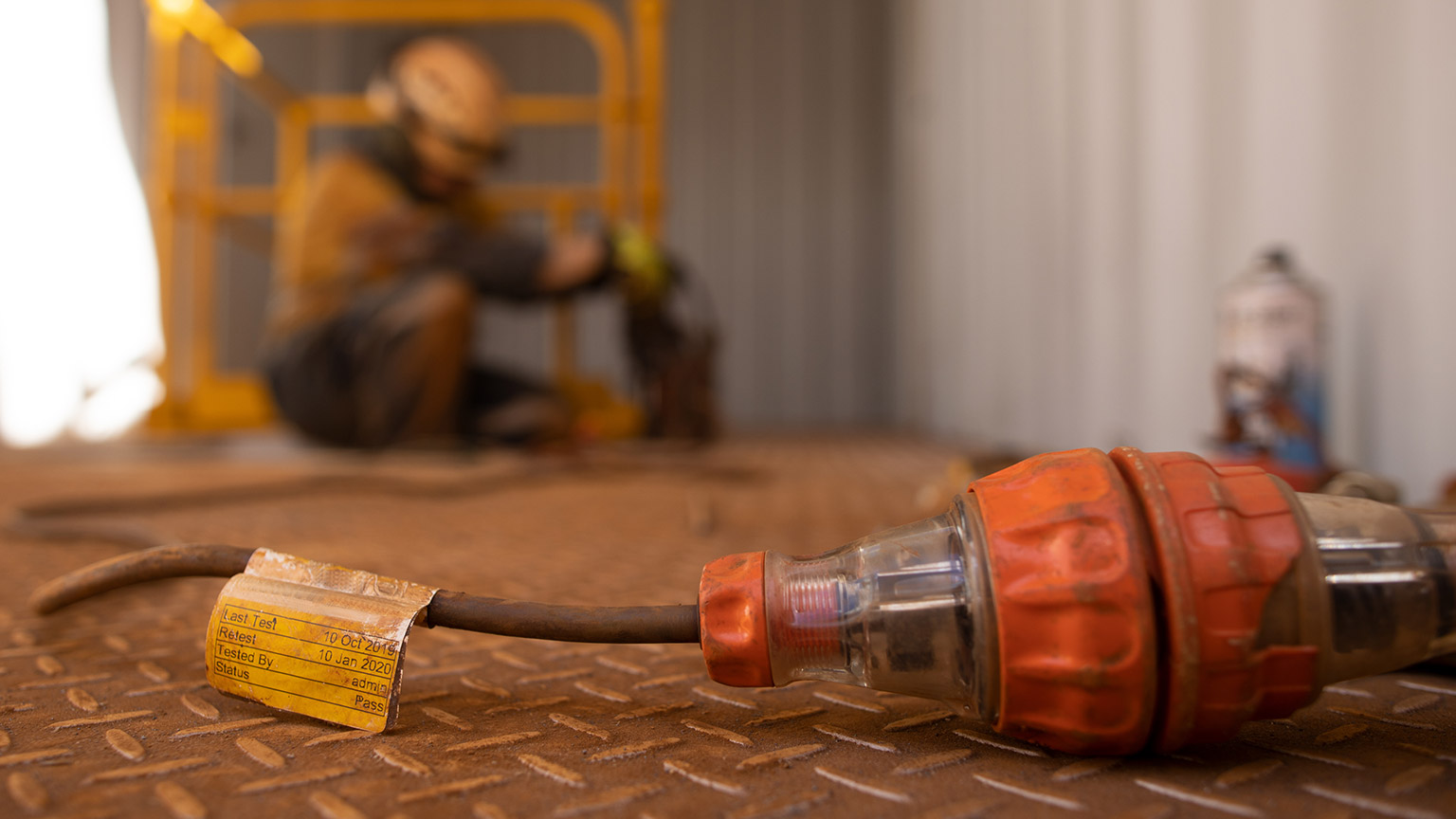In this topic we will look at how you will keep yourself safe while working around electricity. We’ll start by looking at the dangers involved, and then move onto safe working practices. This knowledge will link with what you learn on your First Aid course.
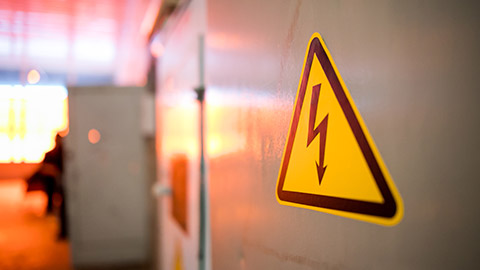
What we are covering:
- shock
- electrocution
- burns
- falls
Electricity is something that we cannot live without in our modern world, but it is also something that we need to treat with respect and always be aware of the danger when we are working around it. No device will completely protect you from being electrocuted, so always keep safety in mind.
Working with electricity can go horribly wrong. Read the article "Life is fragile tragic real-life examples of electrocutions". Be sure to click on the links to stories of two electrical apprentices working in ceiling spaces. Warning: in both stories the apprentices did unfortunately pass away as a result of their injuries.
Injuries from Electricity
There are four main types of injuries: electrocution (fatal), electric shock, burns, and falls. These injuries can happen in various ways:
1. Electrocution
Electrocution is death or severe injury caused by electric shock.
2. Electric shock
Electric shock is the effect of an electric current flowing through the human body either through direct contact with exposed energized conductors or circuit parts, or when electricity arcs (jumps) from an exposed energized conductor or circuit part (e.g., overhead power lines) through a gas (such as air) to a person who is grounded.
The severity of injury is based on:
- The amount of current.
- The duration of current.
- The path of current through the body. (Current travelling from arm to foot is likely to go through the heart, making it more dangerous than current travelling between a leg and the ground.)
Electrical current interferes with the electrical processes of the human body namely nerves, muscles and heart. Current flowing through the:
- Heart causes fibrillation of the heart - a breakdown of the pumping coordination of heart muscles that will not correct itself.
- Muscles causes contraction of the muscles – not only skeletal muscles preventing the shock victim from ‘letting go’, but the diaphragm muscle controlling the lungs and heart can also be "frozen" resulting in asphyxiation.
- Brain causes a loss of consciousness and seizures.
The following figures combine to illustrate the likely physiological effects of electric shock on the human body, for variations in the amount of electric current flowing through the body and time of exposure:
| Zone | Effects of electric shock on the human body | |
|---|---|---|
| 1 | Perception possible but usually no 'startled' reaction | |
| 2 | Perception and involuntary muscular contractions likely but no harmful side effects | |
| 3 |
|
|
| 4 |
Patho-physiological effects may occur:
Injuries may result in death |
Probability of ventricular fibrilation up to about 5% |
| 5 | Probability of ventricular fibrilation up to about 50% | |
| 6 | Probability of ventricular fibrilation above 50% | |
Activities
Complete the following learning activities on the effects of electricity on the human body.
Complete the table to explain the effect of current passing through the body of a person in average good health and condition.
Refer to the two diagrams above to choose which zone the body current is in (numbers 1-6).
Use the corresponding letter for each of the possible effects. You may use the same letter more than once.
3. Burns
Burns occur when current passing through your body is transformed into thermal energy as a result of the body’s resistance. Contact burns from being shocked can burn internal tissues while leaving only very small injuries on the outside of the skin.
Burns may also be the result of heat generated by an electric arc, and flame burns from materials that catch on fire from heating or ignition by electrical currents or an electric arc flash. Ultraviolet (UV) and infrared (IR) light emitted from the arc flash can also cause damage to the eyes.
An arc flash is a release of electrical energy that causes an explosion, reaching temperatures of up to 20,000 degrees C. It usually occurs in large switchboards but may occur in smaller switchboards and large electrical equipment.
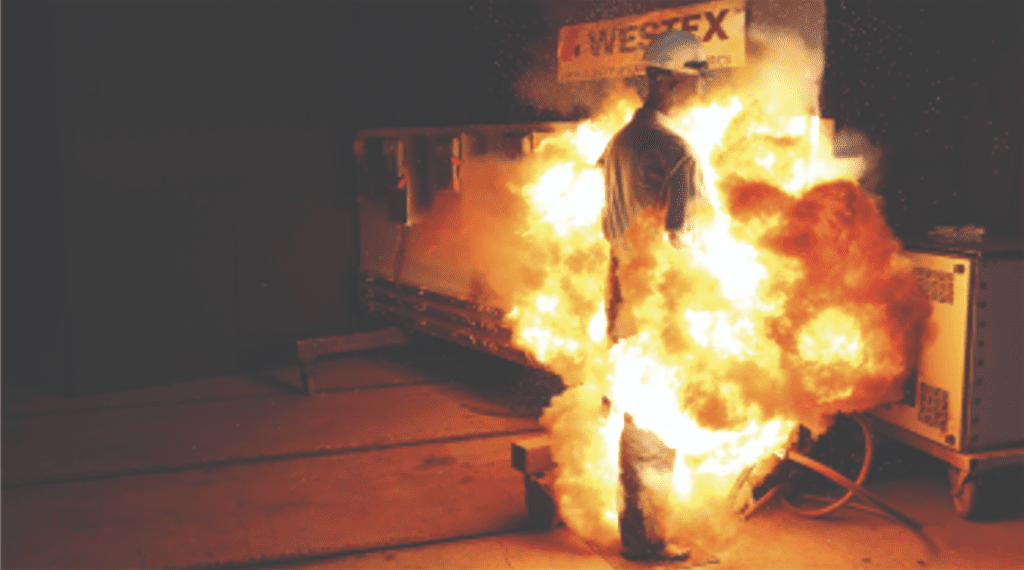
An arc flash can result in blast injuries, lung injuries, ruptured eardrums, shrapnel wounds, burns and blindness.
Watch
What is Organisational Behaviour? Definition and History of the Field
The message from this video by WorkSafe Queensland is: that the only way to protect yourself from an arc flash incident is to choose not to work ‘live’.
Duration: 2.19
4. Falls
Falls due to an electric shock can also result in serious injuries. They tend to occur due to muscle contractions, or a startle reaction, causing a person to fall from a ladder, scaffold or aerial bucket.
This is particularly common when people are doing house or garden maintenance such as pruning large trees that are near electrical cables.
Summary
Working with electricity is risky and the best way to protect yourself and the people is to follow safe practices and procedures. We’ll be looking at this next.
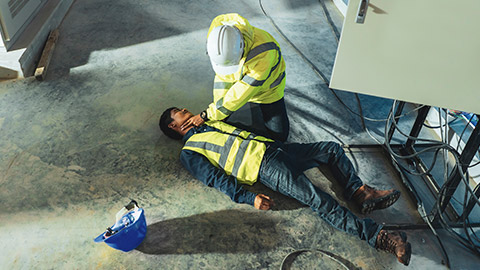
What we are covering:
- responding to electrical incident
- first aid checklists
You're working on site and come across your colleague lying on the ground. What do you do?
If a co-worker has come into contact with electricity, they may not be able to remove themselves from the electrical source.
Do not attempt to pull the person from the electrical source with your bare hands, you may be electrocuted!
Remember, your body is a good electrical conductor, so if you touch the person while they are connected to the electrical source, the electricity will flow through your body too. If you suspect that someone has come into contact with electricity, follow these steps:
- Call emergency services.
- Attempt to turn off/disconnect the source of the electricity. The longer a person is in contact with the power source, the more likely the shock will be fatal. The action you take will depend on whether the risk is posed by high voltage or low voltage electricity:
High Voltage – e.g. overhead power cables. High voltage electricity has the ability to 'jump' or 'arc' pass through soil, water, metal or even people or animals up to 8-10 meters away from a fallen power line. DO NOT APPROACH! Keep a safe distance from the victim until the power has been switched off by an official agency.
Low Voltage - turn off the source of electricity if you can safely do so. If this is not possible use an insulated object such as a broom with a dry wooden handle to push the victim clear of the source of shock. Stand on a dry insulating material (book or rubber matting etc) or wear rubber soled shoes for added protection. Never choose anything damp to help rescue the victim. - Once you have removed the victim from the electrical source, administer appropriate first aid. (If you have not had first aid training, the emergency operator will advise you until help arrives.) The ‘DRSABCD’ of resuscitation is the method used to assess collapsed patients.
| Observe/check | Action | ||
|---|---|---|---|
| D | Dangers |
Check for hazards & risks. Check scene safety for:
|
If possible, eliminate, isolate or minimise hazards & risks. Only move the casualty if there is a clear reason to do so. |
| R | Response (alert voice pain unresponsive) | Check for response | Shout and tap |
| S | Send for help | Send for help. Call an ambulance immediately if no response. Consider AED. | |
| A | Airway | Consider airway obstruction | If no response, open airway (head tilt/chin lift) |
| B | Breathing | If unresponsive and not breathing normally | Start CPR |
| If unresponsive and breathing normally | Position the casualty on their side | ||
| C | Circulation/CPR | If not breathing normally | Start CPR |
| If bleeding | Use direct pressure to control bleeding | ||
| If showing signs of shock | Treat shock | ||
| D | Defibrillation | Attach AED ASAP as needed (if casualty isn't breathing normally) | |
| General care | When/if breathing normally, position the casualty on their side. Monitor and reassure the casualty | ||
- Burns - Exposure to electricity can cause burns to the skin, and in severe cases, the internal organs. For responsive casualties, cool burns for a minimum of 10 minutes under cold water and for unresponsive casualties cool the burn with wet dressings (or special burn dressings) after placing them in the recovery position.
- Muscle spasms/seizures may be present for some time after exposure to electricity and indicate a seriously ill casualty.
- Assist the casualty to the ground and remove any objects that may cause injury if struck.
- Place padding under the head - clothing if necessary.
- DO NOT place anything inside the casualty's mouth.
- Loosen any clothing that may restrict the airway.
- Try to time the seizure.
- In all cases of electric shock, even if the victim feels fine, seek medical treatment and advice immediately, as certain organs/systems within the body may be affected several hours after a shock.
Note – As part of this Level 3 qualification you will complete First Aid and CPR training. Your tutor will advise when this is scheduled for.
In the meantime, you might consider downloading this App to your phone.

Activity
How well can you do in this safety quiz?
Activity
- Find out what Static Electricity is and write a definition in your own words. What are some examples? (Add information to your glossary.)
- What is the difference between AC and DC current flow?
Have you ever wondered why:
- Birds can safely rest on high voltage power lines without getting shocked?
- Removing a plug with wet hands dangerous?
- Putting a knife into a plugged-in toaster is dangerous?
Use the internet to find out the answers and write notes. Post your findings in the class discussion forum.
Forum Task:
Use the internet to find out the answers and write notes. Post your findings in the class discussion forum.
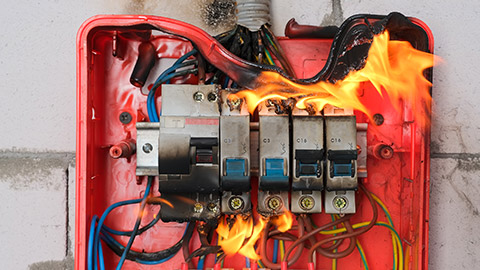
What we are covering:
- hazards and risks
- Unsafe equipment/installation
- Unsafe environments
- Unsafe work practices
A hazard is something that can cause harm, e.g. electricity, chemicals, working up a ladder, noise, stress, etc.
A risk is the chance, high or low, that any hazard will actually cause somebody harm.
Activity
What are some of the hazards found in the electrical workplace? Photograph any hazards at the campus and upload your photos to the group forum. Comment on the risk level of each hazard.
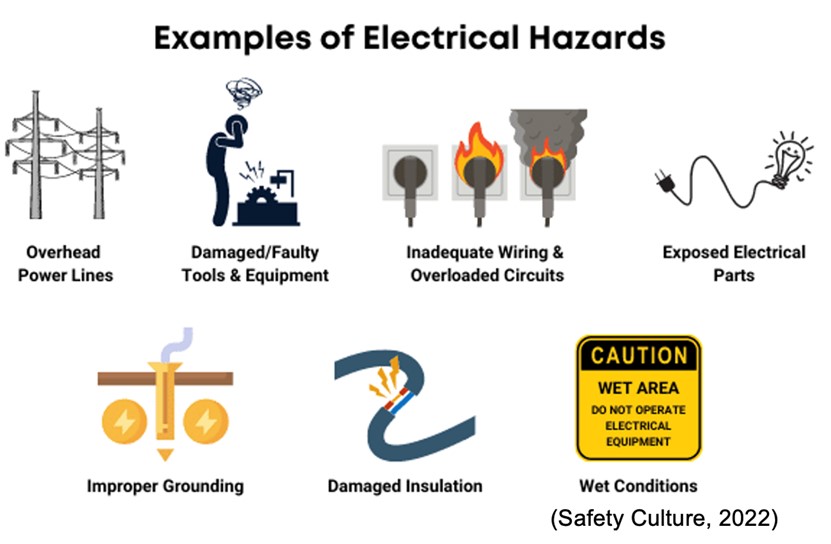
Electrical accidents are caused by:
1. Unsafe equipment and/or installation
Electrical equipment becomes a hazard when it is exposed, damaged, defective or used incorrectly.
- Ensure live parts of electrical equipment (operating at 50 V or more) are guarded against accidental contact by screens and covers.
- Check all live wires are properly insulated.
- Examine tools and equipment for cracks, damaged insulation, broken ground pins, frayed cord lines, or loose parts.
- Adequately ground power supply systems, circuits and equipment and use protective devices such as GFCIs, fuses and circuit breakers.
- Avoid overloading a circuit, resulting in heated wires and fire.
- Use wires of correct size for the operation and electrical load and extension cords designed for heavy-duty use.
2. Workplaces made unsafe by the environment
Your work environment has a number of hazards, such as power lines, underground services and excessive water. Over half the fatal electrical accidents each year are caused by contact with overhead lines.
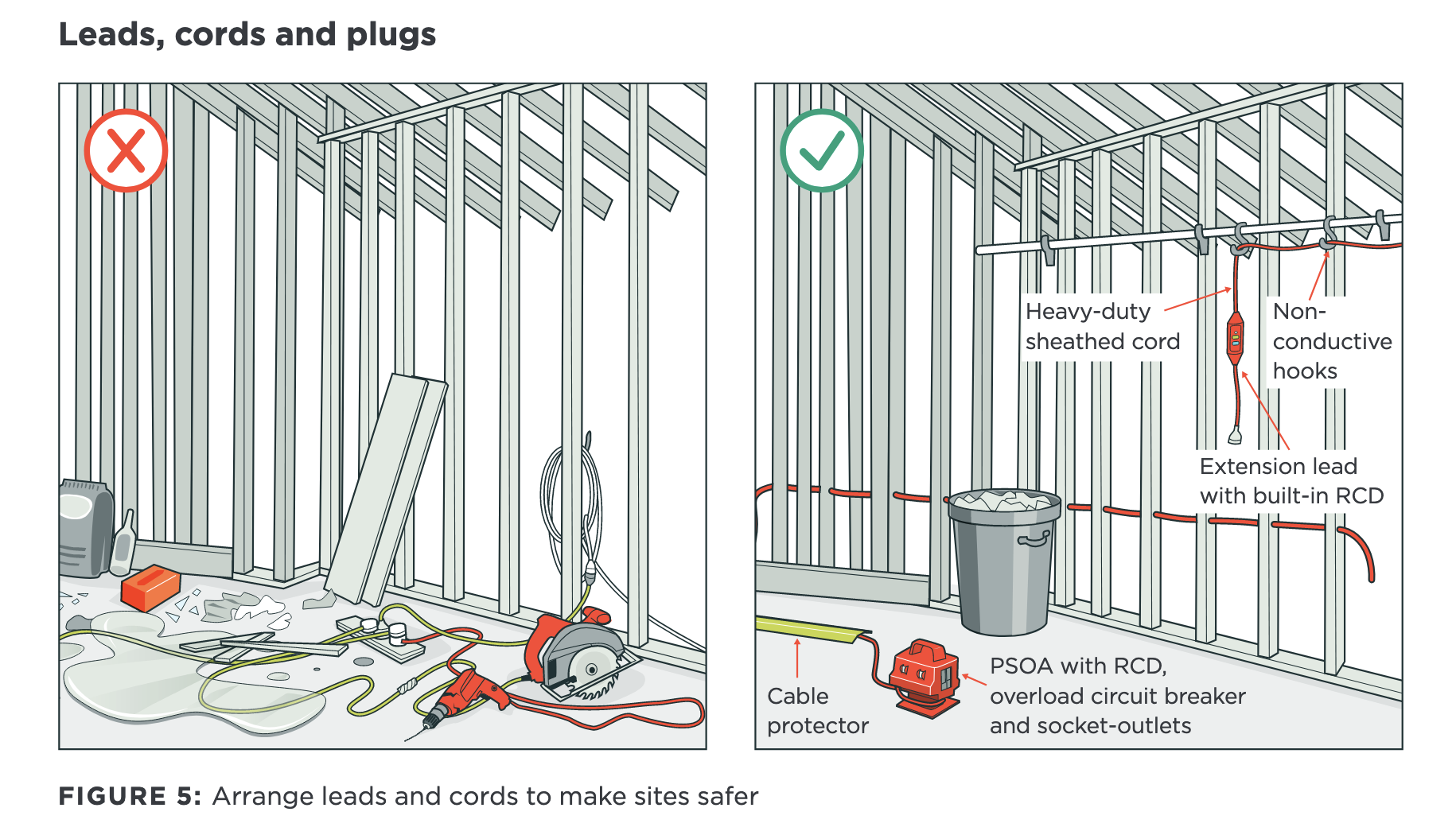
- Keep floors and work surfaces dry so that electrical equipment doesn’t come into contact with water or other liquids.
- The electrical supply you are using may become overloaded when there are many contractors on site.
- There may also be risk from electrostatic and electromagnetic fields, chemicals, gases, dust and asbestos.
- Take extra care in a cramped space such as a tank or bin where there is a lot of earthed metalwork – it may be difficult to avoid an electric shock if a fault occurs.
- Keep yourself and equipment a minimum of 4 m away from overhead power lines. Allow 6 m for overhead transmission lines. (NZECP 34:2001)
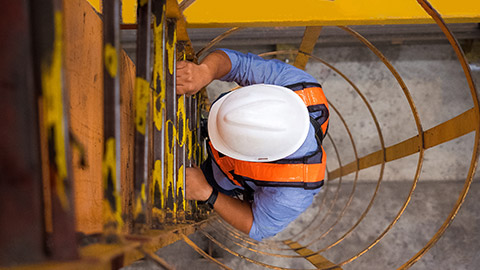
A 28-year-old scaffolder received a severe electric shock on a scaffolding worksite in West Auckland April 2022 when the steel pole he was holding touched low-hanging overhead power lines. Both arms were amputated as a result of his horrific injuries. Read about his story HERE and HERE.

3 Unsafe workers/work practices
Workers themselves can be a hazard. You must:
- Be qualified and authorized to carry out electrical work.
- Follow all Health and Safety regulations and signs.
- Report unsafe conditions immediately.
- Follow good housekeeping practice - keep workplace clean and tidy, keep floor and exits clear of obstructions, store tools and equipment in the correct place, switch off and unplug appliances before cleaning and at the end of the day.
- Wear or use protective clothing and equipment provided.
Watch this clip where a young worker on a scissor lift is electrocuted by overhead wires. Warning: the content contains a reconstruction of what happened to the young worker.
Watch
Incident Investigation: Worker on Scissor Lift Electrocuted | WorkSafeBC
This video recreates an incident where a young worker performing service checks on a scissor lift got too close to an overhead power line and was electrocuted. Overhead power lines and elevating equipment can be a dangerous mix if you’re not properly trained to operate a scissor lift safely. In this incident investigation slide show, we learn that you don't even have to touch a power line to get electrocuted. Similar to lightning, electricity can jump across an air gap (flashover) and cause serious injury or death. This educational video is a helpful training tool for workers who operate scissors lifts and boom lifts. It’s important to educate workers about the hazards, and to implement appropriate risk controls.
Duration: 2.47
Activities
Fill in the blanks with the corresponding letters of words that correctly complete the statements about workplace hazards.
View the OSHA (Occupational Safety and Health Administration) Electrical Slide Presentation. You can access it on your phone via the QR code below or download a COPY to your device. There are links for you to follow, and a quiz at the end!

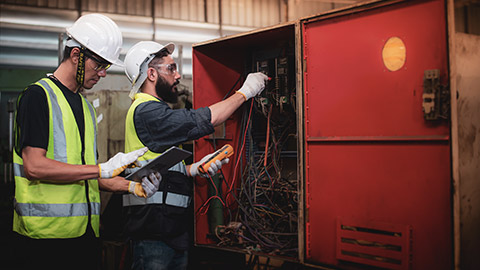
What we are covering:
- training and safety programmes
- grounding
- maintaining distance
The following diagram illustrates some of the most important lines of defense to coming in contact with energized conductors and equipment.
1. Training and Safety Programmes
To ensure employees are using safe work practices, they must be:
- Aware of the electrical hazards they will be exposed to.
- Trained in safety-related work practices as well as any other procedures necessary for safety from electrical hazards.
- Aware of and understand legislation relating to the electrical industry.
Activity
2. Grounding
Electrical grounding creates an alternative, low-resistance path for unwanted current to flow back to the ground if there is a fault in the tool or electrical system. When a short (or lightning) occurs, energy flows to the ground, protecting you from electrical shock, injury, and death.
Electrical equipment must be properly grounded. This includes your home wiring system, plug-in appliances, and devices. If you contact a defective electrical device that is not grounded, the electrical current will take the path of least resistance which will be YOU and you will be shocked.
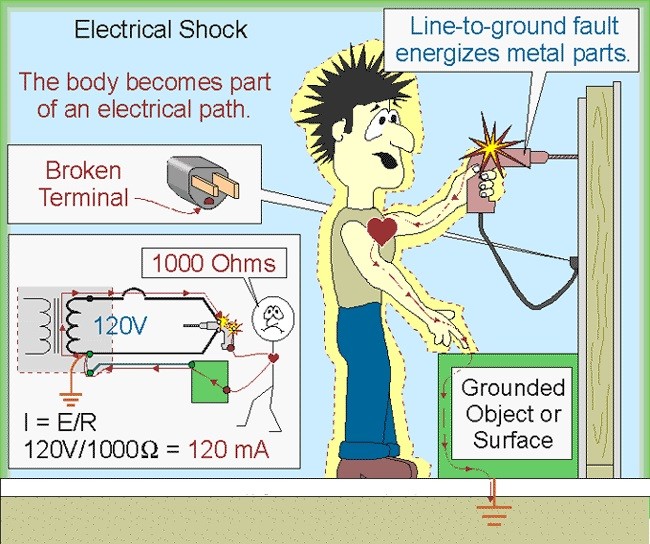
Power tools (and other appliances) are much safer when they have a third prong on the cord plug. The ground (earth) pin safely returns leakage current to ground. The added safety of 3-prong plugs is crucial for any appliance or cable intended for outdoor or wet area usage.
Although you only need two prongs – neutral and active, for a device to function, you should NEVER remove the ground pin and NEVER use an extension cord or electric tool that has a broken or missing ground pin!
Activity
Forum Task
Research the answers to the following questions and report back to the group forum.
In a 'three pin plug', why is the earth pin made longer and thicker than other pins?
Why do some electronics have only two prongs?
3. Maintaining Distance
The best way to stay safe from electrical hazards is to ensure you stay away from them. If you must work in the same area as an electrical hazard or equipment operating on more than 50V, maintain a safe distance.
Physical barriers should always be used to protect employees from any electrical hazards. Always keep cabinet doors on electrical panels closed. Use shields, barriers, or insulating materials if an electrical hazard cannot be fully closed in.
When working near overhead lines, isolate the electricity supply where possible, otherwise maintain a minimum approach distance (MAD) to keep your body, tools and equipment a safe distance from the overhead line.
Activities
Write the exact answers from the New Zealand Electrical Code of Practice for Electrical Safe Distances (NZECP 34:2001) in the blank spaces below.
Research answers to the following questions. (Ensure your sources relate to New Zealand situations.) Post your answers to the forum page.
What is the ‘safe distance’ to work near to:
- Overhead powerlines
- Overhead transmission lines
- What should you do if your vehicle (with you inside it) comes into contact with a fallen power line?
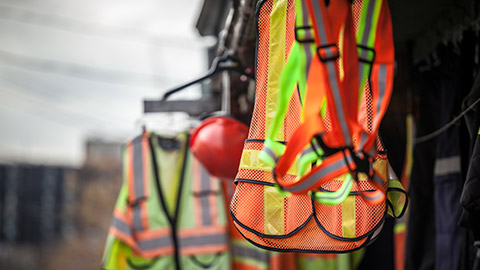
What we are covering:
- Tools and equipment
- Personal protective equipment
- Preventing electrical accidents can be as simple as using the correct tools and wearing appropriate safety clothing and equipment.
Tools and equipment
When electrical tools are working properly a complete circuit is maintained between the tool and the energy source.

However, if the tool is damaged the person may come into direct contact with the electricity and become a path for the current, resulting in electric shock.
Before using any electrical tool or extension cord, it is a good idea to inspect it completely for damage such as cracks, damaged insulation, broken or removed ground pins, loose parts, frayed line cords etc. If there are any defects, the tool must be taken out of service until repaired by a Registered Electrician.
SiteSafe Te Kaitiaki o Haumaru makes the following recommendations.
Every day:
✔ Check that all electrical equipment is RCD-protected (RCD= residual current device).
✔ Test RCDs using the test button, including RCDs on PSOAs (PSOA= portable socket-outlet assembly)
✔ Look at the general condition of electrical equipment (including cords and leads) before use.
✔ Check for visible signs of damage or faults
✔ Makes sure the equipment operates the way it's supposed to (e.g. that the trigger switch on a drill responds to pressure).
✔ Check that suitable personal protective equipment (PPE) is being used, along with other controls.
✔ Check equipment is protected from weather and other environmental hazards.
✔ Make sure that leads and cords are arranged, used and stored safely.
Activity
Create your own list of 10 safety tips when using tools and equipment and post on the Forum.
A double-insulated tool is a tool that is encased in plastic, which prevents the user from electrocution if the tool develops a short circuit.
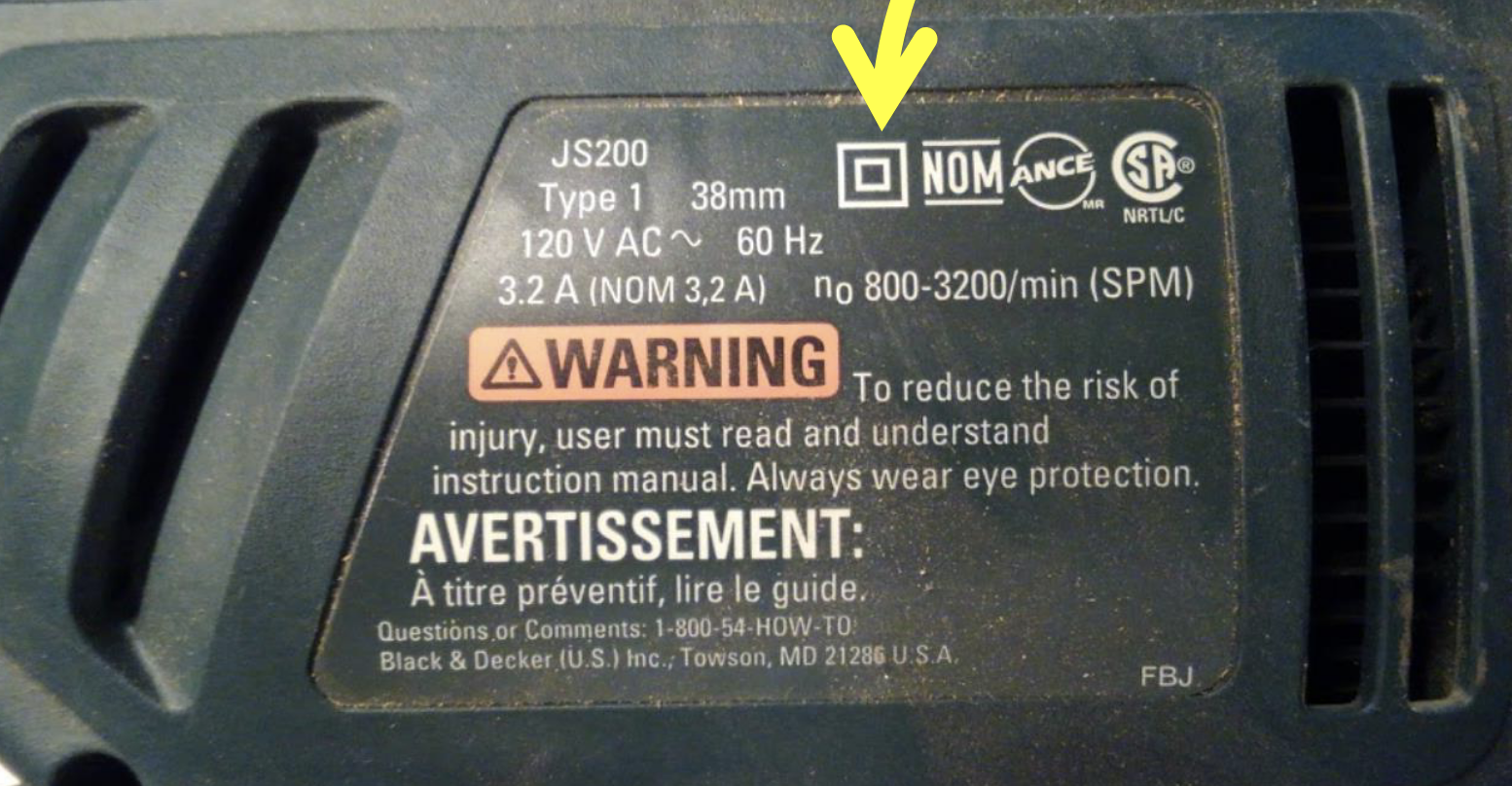
Double-insulated tools are identified with a square-within-a-square logo or the words “double-insulated” on the label. Double-insulated equipment does not require grounding.
Activity
Personal protective equipment
Personal protective equipment (PPE) helps keep you safe on the job, but it should be the last line of defence once all other reasonable actions have been taken to eliminate or minimise risks to your health and safety.
Visit WorkSafe Mahi Haumaru Aotearoa to learn more about PPE.
The site has various guides. Familiarize yourself with these and then answer the following questions.
Activity
Activity
A full risk assessment must be undertaken before it is decided which PPE should be worn by an electrician. Investigate the most important items of electrical PPE and their purpose. Choose 3. Post findings on the class forum.

What we are covering:
- testing and tagging
- circuit protection devices
- lock out/tag out
Good workplace practices and procedures will go a long way towards avoiding accidents and injuries caused by exposure to electricity.
Testing and tagging
All electrical appliances, tools and leads should undergo regular testing to ensure the safety of those coming into contact with the appliance, as well as minimizing the risk of an electrical hazard.
‘Test and Tag’ involves two parts:
- Visually inspecting the appliance for any damage.
- Electrically testing it with a Portable Appliance Tester.
Once tested, the item is tagged to confirm it has been tested, along with information about who tested it, the test date and when the next test is due.
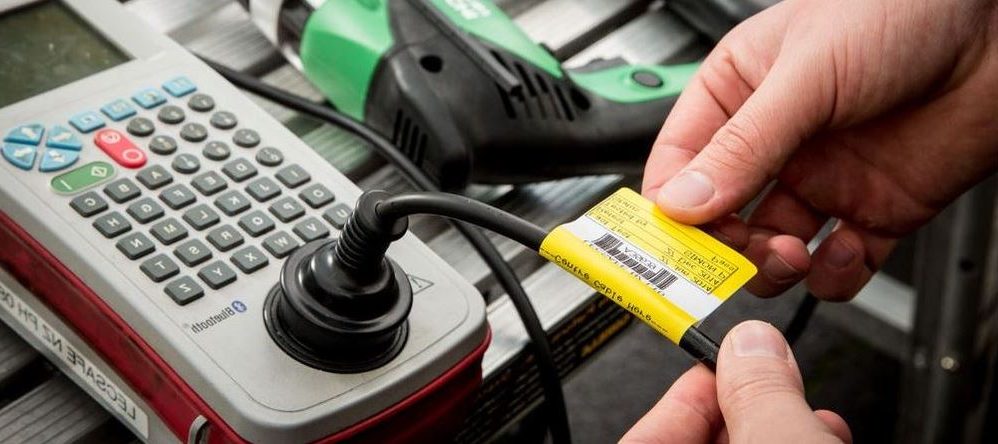
Testing and tagging is widely used but not mandatory. It is an indication of how safe the appliance is at the time of testing but does not guarantee future electrical safety. The Electricity Act 1992 requires all electrical products to be of a high quality and standard, so that their construction and maintenance meets the safety requirements within the Electricity (Safety) Regulations 2010. The Act requires a person to take all reasonably practicable steps to prevent serious harm. Test and tagging to AS/NZS 3760 is a widely recognised way to meet those safety obligations.
Activity
Circuit protection devices
Circuit protection devices are designed to automatically limit or shut off the flow of electricity in the event of a ground-fault, overload, or short-circuit in the wiring system. Fuses, circuit breakers, and residual current devices (RCDs), or ground-fault circuit interrupters (GFCIs) as they are known in the U.S., are all examples of such devices.
Fuses and circuit breakers are over-current devices. When there is too much current:
- Fuses heat up and melt if there is too much electricity passing through and into a power system. Unlike circuit breakers, fuses must be replaced after they have done their job of halting abnormal electricity flow.
- Circuit breakers trip open. They can be reset either automatically or manually.
- Surge Protectors work to prevent voltage spikes from damaging equipment (usually in the home) by diverting voltage to ground or straight up blocking extra voltage.
RCDs are fast-acting circuit breakers that continually match the amount of current coming and going to an electrical device. Mismatches as small as 5 milliamps will result in the circuit being tripped. While RCDs don’t do much to protect equipment from electricity overload or short-circuits, they are very effective in limiting the damage caused by electrical shocks.
The best place for an RCD is built into the main switchboard or the socket outlet, as this means that the supply cables are permanently protected. If this is not possible, a portable device for mobile operations such as a contractor on a site plug can provide additional safety.

Remember:
- An RCD is a valuable safety device, never bypass it.
- When an RCD trips, it signals a fault – check the system before using it again.
The RCD has a test button to check that its mechanism is free and functioning – use this regularly.
Activity
Lock-out/Tag-out
Using a lock-out/tag-out program is another way to keep electrical workers safe. Never work live on switchboards, fittings, conductors or equipment. Lockout procedures ensure electrical machines are completely turned off and unable to restart until maintenance and repair work is completed.
- Locking the power switch in the off position prevents someone from inadvertently turning the equipment back on while maintenance is underway.
- Once the on/off switch is securely locked out, the switch must be tagged. Tags identify equipment or circuits being worked on.
- The lock and tag are warning signs, alerting others as to why the switch is off.
- If you see equipment that is locked and tagged do not touch it - it is locked and tagged for a reason.
- If you are required to work on electrical equipment you must be trained in lock-out/tag-out procedures specific for that site.
Activity
This completes the section on accident prevention. Always keep in mind:
- Look after yourself and your mates. Don't take shortcuts around known safety rules just because you think you might be able to do the job easier or faster.
- Report all hazards, risks, incidents, accidents and injuries. Doing this will allow you, your workmates, the organisation you work for and the organisations you work with to identify ways to stop these things from causing harm to you and your mates.
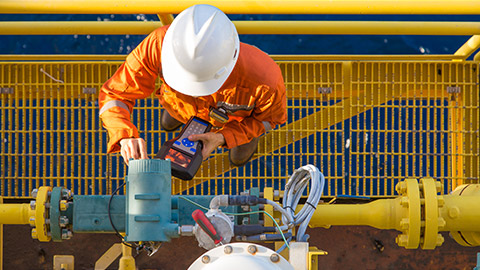
What we are covering:
- risk assessment
Identifying potential risks before they happen by performing a risk assessment helps keep electrical workers safe onsite.
Activity
Visit the following sites to learn more about Risk Management when carrying out electrical work. Make notes for your own learning. What are the most important points from each website?
Electrical workers face risks on the jobsite every day. All activities and workplaces have potential risks and hazards. You can’t avoid risks, but you can manage them. A risk assessment helps identify hazards, assess risks, and implement risk controls before beginning work at a site. It should answer the following questions:
- Is a hazard present?
- Is an injury likely to occur?
- What is the severity of the potential injury?
- How can the risk be managed according to the hierarchy of risk controls?
Carrying out a Risk Assessment
Step 1 – identify the hazard
A hazard is anything that can cause harm to people, equipment, or property. It may be an activity, event, process, situation, equipment, substance, or behaviour.
Step 2 - Assess the Risk Level of Each Hazard
The risk is a measure of how likely a hazard is to harm someone and how serious the harm could be. To determine a risk rating, consider:
- The likelihood – chances or possibility of it occurring.
- The consequence – what will happen, the extent of the harm.
A risk matrix like the one below is commonly used to identify the level of risk for a particular hazard. Management can then make decisions and take actions based on the outcomes.
| Likelihood | ||||||
|---|---|---|---|---|---|---|
| Rare | Unlikely | Possible | Likely | Almost certain | ||
| Consequences | Major | Moderate | High | High | Critical | Critical |
| Significant | Moderate | Moderate | High | High | Critical | |
| Moderate | Low | Moderate | Moderate | High | High | |
| Minor | Very low | Low | Moderate | Moderate | Moderate | |
| Insignificant | Very low | Very low | Low | Moderate | Moderate | |
Activity
Identify two common hazards on campus and assess using the risk using the matrix above. Post findings to group forum page.
Step 3 - Control the Risk to Reduce the Harm and Severity
After assessing the likelihood of occurrence and severity of a potential injury, it’s time to implement risk controls based on a hierarchy.
| Risk Level | Explanation |
|---|---|
| 1. Elimination | Temporarily eliminate the hazard to establish an electrically safe work condition. |
| 2. Substitution | Substitute less-hazardous equipment, such as using non-electrical or battery-operated tools instead of cord- and plug-connected. |
| 3. Engineering controls | Choose options that automatically reduce risk, including GFCI protection or factory-installed barriers |
| 4. Awareness | Alert people to the hazard by installing permanent or temporary signs, labels, barricades, etc. |
| 5. Administrative controls | Complete all initial work, such as establishing planning processes, attending training, obtaining permits, and clarifying work procedures. |
| 6. Personal Protective Equipment (PPE) | Ensure personal protective equipment (PPE), such as insulated tools, clothing, and gloves, are available when needed. |
Step 4 - Document a risk management plan
Document a risk management plan detailing how the plan is to be communicated, implemented, monitored and reviewed. Include who is responsible for each step.
Activity
Read the paragraph below about controlling hazards, then fill in the blanks with the corresponding letters of the words listed.
Activity
Move the correct titles to the corresponding sentences.
Activity
Activity
Read the WorkSafe information about electrical safety on small construction sites. Make notes for your own learning. What is the key message from this website?

What we are covering:
- how to conduct a risk assessment
Risk assessment is a careful examination of what could cause harm, injury or ill health to people in the workplace. Before starting any job, you must ensure an assessment has been made of any electrical hazards. The risk assessment should take into consideration the type of electrical equipment used, the way in which it is used and the environment that it is to be used in. By assessing the risks, you can decide whether enough precaution has been taken or whether more should be done to prevent harm.
Identify the hazards:
- walk around the workplace looking at what might cause harm
- check accident and incident forms to see what previously caused harm
- consider long-term hazards to health
- describe hazard and how it might harm people, equipment and property.
Assess risk level:
- use a risk assessment matrix to identify the likelihood of it happening and the consequences or severity if it happened.
Control the hazard:
- can the hazard be eliminated altogether?
- if not, then how can it be minimised? (use hierarchy of controls)
Make a plan of action:
- record findings
- describe how you intend implementing the controls.
Review and update regularly:
- reviews are necessary since procedures change, equipment is updated, new staff come onboard etc.
A risk assessment might look like this. (Five separate hazards have been identified.)
| Hazard | Description | likelihood | Consequence | Risk level | Current control measure |
Further risk mitigation measure | likelihood | Consequence | Residual risk level |
|---|---|---|---|---|---|---|---|---|---|
| Fire & electrical shock | During welding process there is flammable substance (paper, thinner) or welding on a wet floor | B | 4 | H | No flammable substance, no paper near welding area & equipped with fire extinguisher. Welding warning sign, PPE & clean welding environment is a must. All welders have attended the welder training from approved agent. | Provide in-house fire safety, welding safety & general safety training for all welders | D | 2 | L |
| Skin burn injury | Welder or worker is affected | C | 3 | M | Welder must be equipped with PPE. All welders have attended welder training from approved agent. | Provide in-house fire safety, welding safety & general safety training for all welders | D | 3 | M |
| Inhalation | During welding process, welder inhales fumes | D | 2 | L | Open area or with electric fan. All welders have attended welder training from approved agent. | Provide in-house fire safety, welding safety & general safety training for all welders | E | 2 | L |
| Radiation | During welding process, welder's skin might be exposed to bright flash | D | 2 | L | Must wear long sleeves/arm covers/ coveralls to prevent skin exposure to bright flash | Provide in-house fire safety, welding safety & general safety training for all welders | E | 2 | L |
| Arc-eye or eye hurt by slag | During welding, bright flash will appear. After welding, slag needs to be removed. If welder doesn't have PPE, eyes can be damaged by bright light or slag | E | 1 | L | Welder has been equipped with PPE. All welders have attended welder training from approved agent. | Provide in-house fire safety, welding safety & general safety training for all welders | E | 1 | L |
To understand this table, first you need to grasp the 2 dimensions of risk:
| Likelihood of occurrence | Severity of consequence(s) |
|---|---|
| A. Almost certain (e.g. fire and electrical shock) | 1. Insignificant (e.g. eye hurt during slag removal) |
| B. Likely (e.g. skin burn injury) | 2. Minor (e.g. welding fumes with inhalation problem) |
| C. Moderate (e.g. radiation) | 3. Moderate (e.g. extremely bright flash) |
| D. Unlikely (e.g. inhalation) | 4. Major (e.g. contact with hot welded pieces) |
| E. Rare (e.g. arc-eye and eye hurt by slag) | 5. Catastrophic (e.g. electrocution) |
Activity
Research other risk assessment forms online looking at the categories/headings they use. Note the requirements when completing a risk management task.
Activity
Identify one common electrical hazard and complete a risk assessment similar to the example above.
